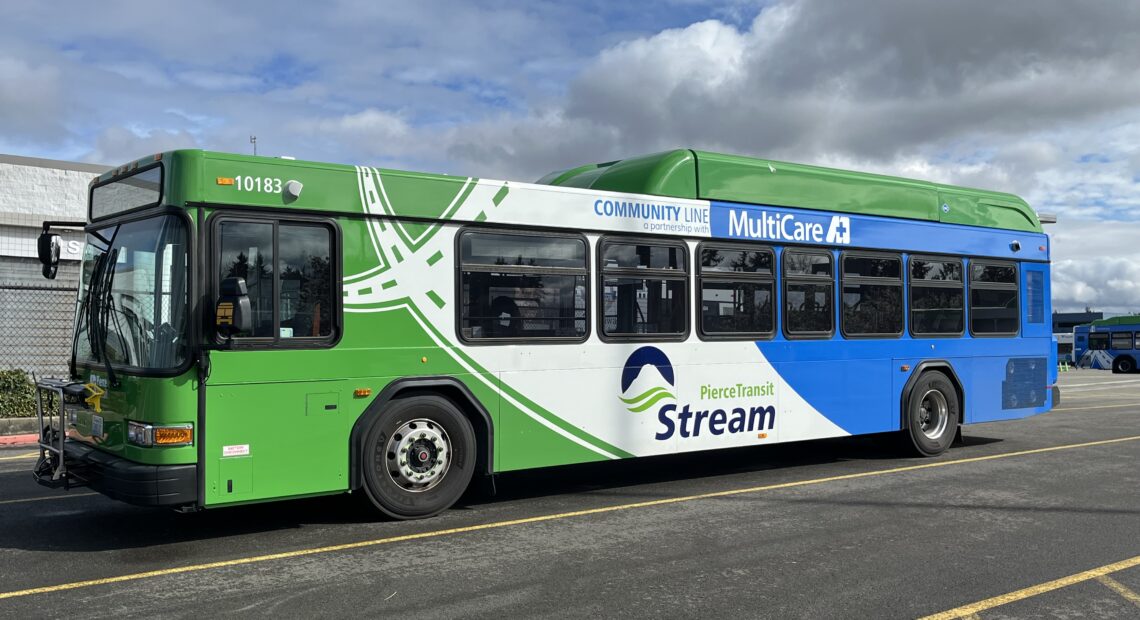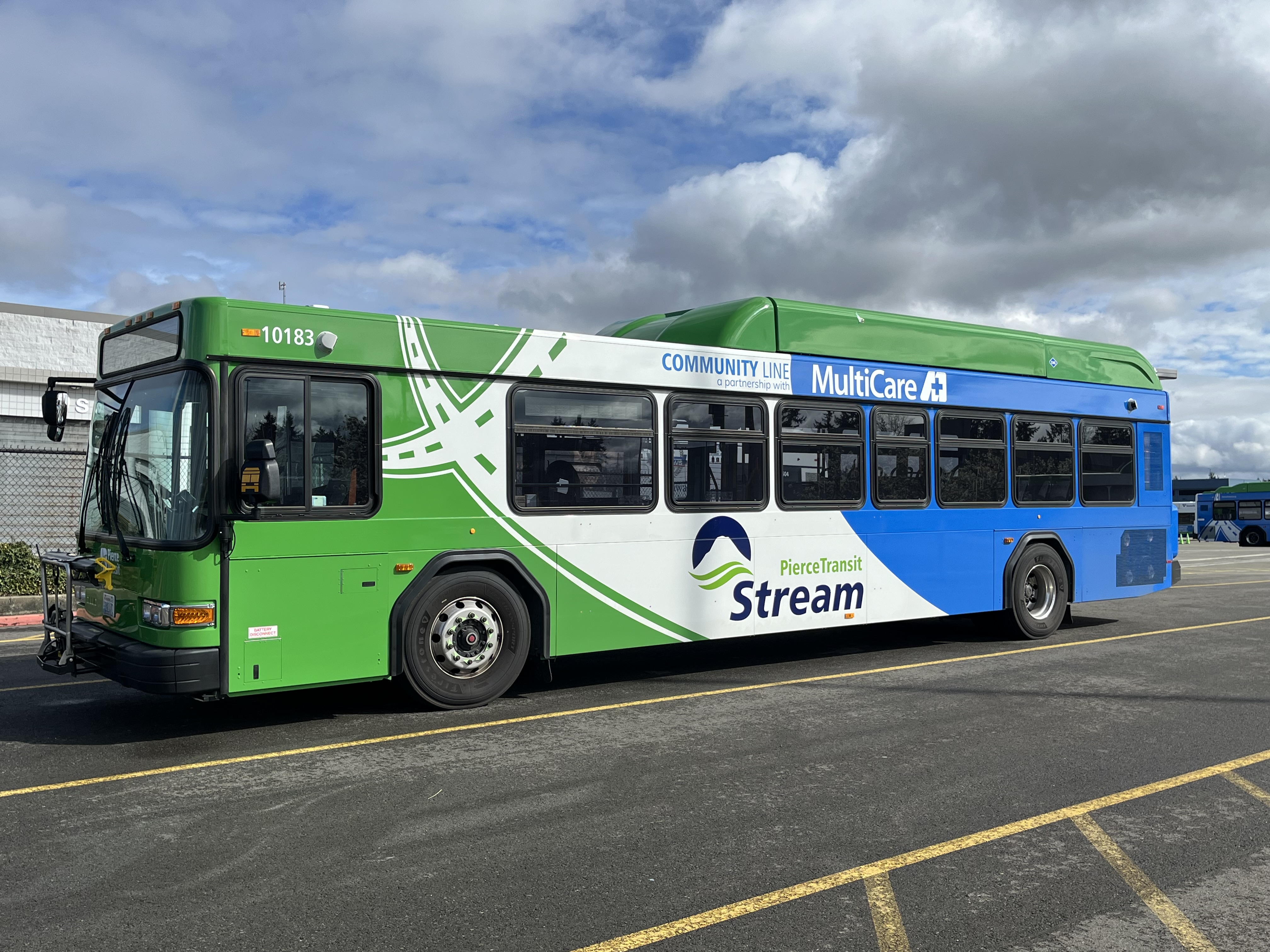
Service changes begin March 31 for Pierce Transit, lack of funding means no new routes
Listen
Read
Big service changes are going into effect for Pierce County’s public transportation system.
While Pierce Transit makes changes throughout the year, Rebecca Japhet, who handles communications for the public transit operator, said these service changes are the biggest the company has made in seven years.
The changes include the retiring of some routes, expanded on-demand runner service in Gig Harbor, and expanded service for weekdays on the transit’s most popular route, Route 1.
“We know that the more buses that come, the easier it is to use,” said Kristina Walker, Pierce Transit board chair and at-large Tacoma City Council member.
The changes are the first in a multi-phase plan for the transit operator’s post-pandemic recovery.
Pierce Transit is operating at 76% of pre-pandemic service levels for buses. As communities have come out of the pandemic, there has been a rebound in service use. In 2023, ridership went up 22% from 2022, and youth ridership, for whom fare is now free, went up 72%.
The company sought public feedback last year on what service changes would best meet community needs and wants. Japhet said about 750 people responded.
“What we found was that people want to see more frequent service, more frequent bus service in particular, and expanded hours of service,” Japhet said.
From this, the Pierce Transit Board of Commissioners – which includes local elected officials from municipalities in Pierce County – created the six-phase Bus System Recovery Plan.
One thing the transit operator is not doing is adding more routes.
That is something South Tacoma resident Cathie Urwin would have liked to have seen. She said she and her neighbors want a direct South Tacoma to North Tacoma route.
Right now, to travel from South Tacoma to North Tacoma, or vice versa, by public transit, a bus rider would have to transfer in downtown Tacoma.
Urwin also is concerned that increased development in the South Tacoma area is being established without additional transit and parking options.
“They’re doing a lot of development, but there’s not an addition of any routes or service for those areas, along certain roads, which is a bit disappointing,” Urwin said.
The City of Tacoma rates accessibility, including factors such as transit routes nearby and proximity to healthy foods, on its Equity Index Map.
“It’s kind of a situation where they need to have their cars because we don’t really have grocery stores, larger grocery stores close by,” Urwin said. “And taking transit to the grocery stores isn’t necessarily convenient, either.”
Many parts of South Tacoma rank lower than the citywide average for healthy food proximity, while it ranks highly for the number of bus routes nearby.
Pierce Transit said adding additional routes isn’t possible with current revenue streams.
“Unfortunately, we just don’t have the robust funding that would be required to add a whole bunch of additional lines,” Japhet said.
Sales tax revenue helps fund the transit. The operator receives .6% of sales tax collected, so about six cents for every $10 purchase. That comes from retail purchases within the Pierce Transit service border.
“Other transit agencies that are our peers, in particular, a transit agency up in Snohomish County and then in Thurston County, collect double what we do,” Japhet said.
Community Transit in Snohomish County and Intercity Transit in Thurston County collect 1.2% of sales tax for revenue.
To change how much the operator gets from sales tax, the Pierce Transit Board would have to agree to present it as a ballot measure to voters.
“It’s certainly a conversation that the board is going to have and has had,” Walker said. “We want to create the best service we possibly can with the money that we have, so that people see the value in that.”
Prior to any ballot measure, Walker said the board would seek input from the community.
As a Tacoma City councilmember, Walker said the number one thing she hears that people want is more service.
“In a dream world, we would have 15 minutes service on every route,” Walker said. “We know even in a best-case scenario that we don’t have the revenue to do that.”
For the first phase of this plan, the public transit company will retire three routes and the eastern portion of Route 409. The transit’s runner service will make up for the retired routes. That service allows on-demand transportation with smaller, minivan-like vehicles reserved through an app.
Walker said she has tried the runner service and called it “a really smooth system.”
Urwin said she thinks the runner service is a success and would like to see it available in South Tacoma.
There will be no layoffs or staffing reductions with the route closures, Japhet said. The transit, similar to others nationwide, has been impacted by operator shortages and is hiring bus drivers and mechanics.
“We will roll out more service as quickly as we can hire drivers,” Walker said.
With the savings that will come from cutting routes, the transit will establish the Stream Community Line, a weekday service that will run every 20 minutes in the mornings and afternoons, the peak commute time, between Spanaway and downtown Tacoma, along the same line as the popular Route 1.
Japhet said it’s an express service that stops to connect people with other major transit connections. This service will run 14 minutes faster than the pace of the typical Route 1, because it won’t stop at every stop.
“We, the board, wanted to stand this up as quickly as we could,” Walker said.
While riders can begin riding it April 1, continued changes to improve the service, such as adding lights and benches and real-time arrival reader boards to stops, will be implemented over the coming months.
There will be a celebration for the new service on April 22, which is also Earth Day. Service on Pierce Transit will be free that day.
The medical company, Multicare, is, in part, sponsoring that new service, so the Stream Community Line buses will be branded with Multicare identification. Multicare’s sponsorship of Pierce Transit will total $9.3 million over 28 years.
The transit also will add a sixth runner zone to its service for Gig Harbor. That service will be offered seven days a week from 7 a.m. to 10 p.m. Japhet said that service will serve key locations, including St. Anthony’s Hospital and the Gig Harbor Tacoma Community College campus.
















